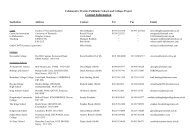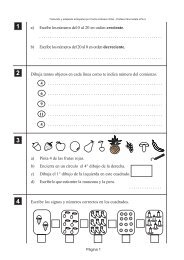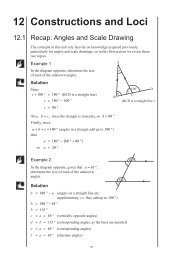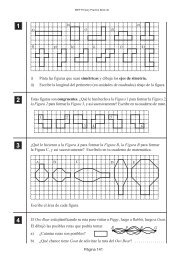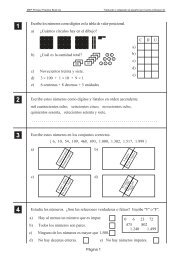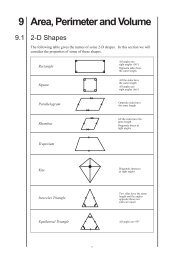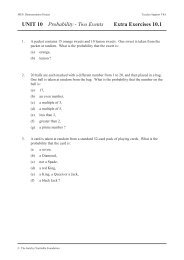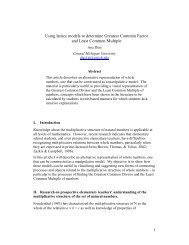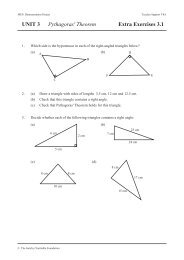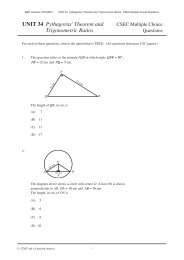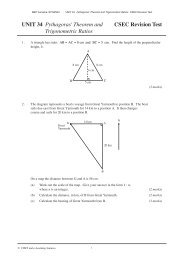It's CAME; We saw; Did it Conquer? – A review of the Cognitive ...
It's CAME; We saw; Did it Conquer? – A review of the Cognitive ...
It's CAME; We saw; Did it Conquer? – A review of the Cognitive ...
You also want an ePaper? Increase the reach of your titles
YUMPU automatically turns print PDFs into web optimized ePapers that Google loves.
curricula demands. However, <strong>the</strong> view was expressed by some <strong>of</strong> <strong>the</strong> <strong>CAME</strong> teachers<br />
that <strong>the</strong> <strong>CAME</strong> approach put a structure onto group work and <strong>the</strong>refore once that<br />
approach had been established, <strong>the</strong> discipline issues did not arise. They did contrast<br />
<strong>the</strong> <strong>the</strong>oretical classroom management s<strong>it</strong>uations portrayed on <strong>the</strong> training videos<br />
against <strong>the</strong> everyday real<strong>it</strong>y and felt that in this aspect some <strong>of</strong> <strong>the</strong> classroom<br />
scenarios were not realistic. W<strong>it</strong>hin both <strong>the</strong> <strong>CAME</strong> and non-<strong>CAME</strong> schools <strong>the</strong><br />
formation <strong>of</strong> groups occurred in different ways; <strong>the</strong> structure <strong>of</strong> groups that appeared<br />
to be favoured was that <strong>of</strong> mixed abil<strong>it</strong>y. This not only allowed peer-tutoring to occur<br />
but also perm<strong>it</strong>ted <strong>the</strong> less enthusiastic pupils to w<strong>it</strong>ness <strong>the</strong> pleasure w<strong>it</strong>h which o<strong>the</strong>r<br />
members <strong>of</strong> <strong>the</strong> class worked. <strong>CAME</strong> teachers did express concern that <strong>the</strong> approach<br />
was time consuming and that ‘<strong>it</strong> can be frustrating if you have certain areas in <strong>the</strong><br />
curriculum to be covered and <strong>the</strong> discussion has led in a different direction’. None <strong>of</strong><br />
<strong>the</strong> <strong>CAME</strong> teachers interviewed found sufficient time to teach all <strong>the</strong> lessons<br />
recommended in <strong>the</strong> <strong>CAME</strong> teachers’ guide or at <strong>the</strong> training sessions. The teachers<br />
expressed <strong>the</strong> view that preparing children for e<strong>it</strong>her internal or external examinations<br />
was an influencing factor in not achieving <strong>the</strong> desired number <strong>of</strong> lessons.<br />
The su<strong>it</strong>abil<strong>it</strong>y <strong>of</strong> <strong>the</strong> <strong>CAME</strong> material for different abil<strong>it</strong>y ranges<br />
In discussing <strong>the</strong> su<strong>it</strong>abil<strong>it</strong>y <strong>of</strong> <strong>the</strong> <strong>CAME</strong> material for all abil<strong>it</strong>y ranges, <strong>the</strong> teachers<br />
felt that <strong>the</strong> ‘middle abil<strong>it</strong>y ma<strong>the</strong>maticians would understand a lot <strong>of</strong> <strong>it</strong>’ and that <strong>the</strong><br />
material was ‘p<strong>it</strong>ched round about <strong>the</strong>ir level’. The teachers in <strong>the</strong> grammar school<br />
expressed <strong>the</strong> opinion that <strong>the</strong>ir ‘bright’ children would be able to work through <strong>the</strong><br />
material quickly although <strong>the</strong>y felt that this group <strong>of</strong> children would be able to<br />
transfer <strong>the</strong> skills and knowledge <strong>the</strong>y had learnt into o<strong>the</strong>r subject areas. The teachers<br />
in <strong>the</strong> non-<strong>CAME</strong> schools, both grammar and non-grammar, did not feel that even<br />
<strong>the</strong>ir brighter pupils would be able to do this. One teacher also articulated <strong>the</strong> view<br />
that sometimes his best ma<strong>the</strong>maticians were also his quieter children in class and that<br />
<strong>the</strong> <strong>CAME</strong> approach had given <strong>the</strong>m an opportun<strong>it</strong>y to articulate <strong>the</strong>ir ma<strong>the</strong>matics<br />
and gain confidence in expressing <strong>the</strong>ir views in class. Ano<strong>the</strong>r teacher felt that<br />
although <strong>the</strong> <strong>CAME</strong> material was useable for <strong>the</strong> weaker student, <strong>it</strong> became very time<br />
consuming because <strong>the</strong> pupils’ weak ma<strong>the</strong>matical knowledge meant that establishing<br />
accurate knowledge took a long time. This teacher felt that <strong>the</strong> teacher guidance<br />
needed by <strong>the</strong>se pupils contradicted <strong>the</strong> ethos <strong>of</strong> <strong>the</strong> <strong>CAME</strong> ideal.<br />
- 9 -



